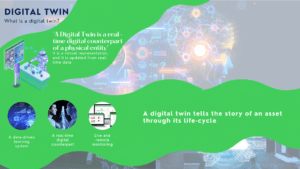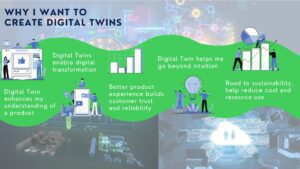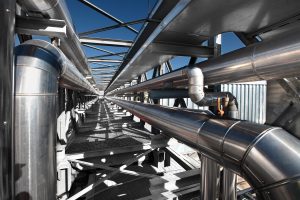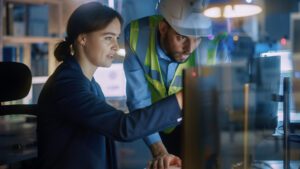In this article, I express my determination to create digital twins and why they are important in my view.
What is a digital twin?
A digital twin is a real-time digital counterpart of a physical entity or system in a digital environment. In other words, it is a virtual representation, and it is updated from real-time data. Hence, digital twins are data-driven learning systems. It uses data from connected sensors to tell the story of an asset all the way through the asset’s life cycle. It typically makes use of IoT, simulation, and machine learning to create digital replicas. One can create a digital twin of practically anything be it as simple as a thermo flask to as complex as a space exploration jet.
Data is collected via sensors attached to a physical asset, then the data is mapped onto a virtual model of the asset hence, the model is able to provide information about the asset in real-time. The virtual model’s capability doesn’t end here. It also uses machine learning and predictive analytics to predict the asset’s future behaviour based on its current behaviour. Future behaviour of an asset is usually expressed in terms of life cycle remaining, number of safe operations remaining, and correspondingly also suggest corrective and preventive measures to improve the asset’s lifecycle and performance.
Now we know not only how products are performing, but also how they will perform in the future. Analysis of the data from the connected sensors, combined with machine learning and predictive analytics, allows us to make these useful predictions.

I feel at this point it is important to draw a difference between digital twins and simulations.
Simulations are mostly theoretical, they duplicate or recreate what could happen to a product, but a digital twin is in real-time. It replicates what is happening to a product in the real world.
Simulations benefit very less from real-time data. Whereas digital twins work around a two-way flow of data and information (source data from sensors digital twins, predictive model insights generated by the digital twin model back to the source).
Simulation changes are limited to the imagination of a designer. However, a digital twin works with real-time data, one can see if a product is working as desired and then determine any improvements.
It is important to appreciate the relationship between IoT and digital twins. IoT consists of devices that are connected and controlled over the internet and a digital twin generally uses IoT to gather data and information. IoT is one of the drivers of digital twin. Collecting and analyzing data is no longer enough, one needs to make better use of the data and technology. Be it for predictive modeling, measurement of different outcomes, or providing better product experience, in this technology IoT and digital twins go hand in hand.
Why do I want to create digital twins?
– A digital twin enhances my understanding of a product, as knowledge is no longer limited to the imagination of an engineer but extended to unseen real-world scenarios as well.
– With just a few taps on my smart device, I am acquainted with a product’s real-time condition. I am not required to be present in the same room as the product, moreover, I can also monitor and control the product remotely.
– Digital twin is a data-driven system- data is not limited to product’s real time conditions, it also consists of results of various simulations and predictive analyses. With all this data and information, I can make quicker and better decisions which will enable me to deliver more rapidly and of high quality.
– A digital twin helps me go beyond intuition as it shows me product facts, the real data, and these facts will help me support or contradict my intuition. It opens doors to more possibilities, and anomalies that I otherwise might have never been aware of.
– With the help of digital twins, I will be able to provide the customer with a better product experience, which in long term will build customer trust and reliability.
Digital twins enable digital transformation, they cause digital disruption by changing how data is exchanged, and by changing the way problems are resolved. They enable digitalization, which is inevitable in today’s world. Especially in the recent time of a pandemic that calls for remote monitoring and control- a digital replica.
They pave the road to sustainability, help reduce costs and resource use, and trigger a more circular economy where products are designed for easy reuse and repurposing while at the same time eliminating waste from the life cycle.
We will soon be taken over by cognitive digital twins that can perform autonomous activities. Much like AI, they can make calculated decisions and execute actions. Digital twins will be able to impact reality, the virtual system will now be alive, or in other words little to no human intervention is required. Cognitive digital twins can unleash the possibility of automated decision-making for many, which I believe is the future and I want to be prepared for the future.

About Trishala Thakur
Electromechanics/Electrotechnology, Design Engineer (Schneider Electric)



